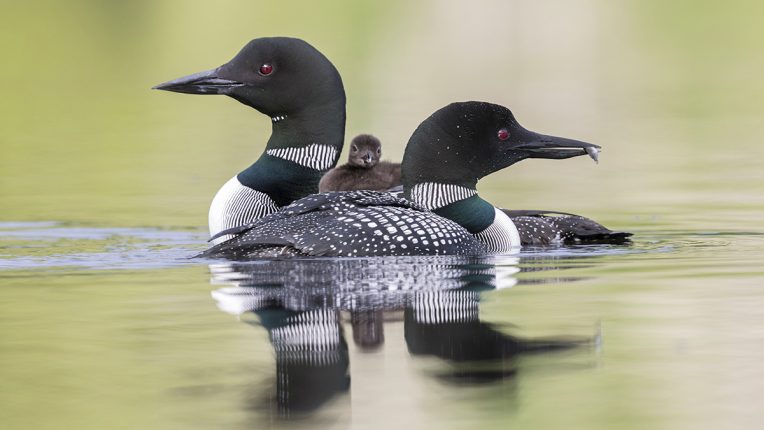[Kevin McGowan, course instructor] Birds are fascinating to watch. They do so many things. They’re always moving, flying, hopping, swimming, singing, or interacting. They’re often climbing, probing, picking, eating, displaying, or doing something that draws our attention.
Sometimes a bird’s behavior is easily understood. A heron catching a fish, or a parrot eating fruit is obviously about getting food. But, sometimes, it’s not easy to tell just what a bird is doing. They can make some odd displays, and do some crazy things. Are they fighting? Courting? Defending a territory? Trying to attract a mate? Or are they using some odd method to find food?
The first step in learning to understand bird behavior is to get a sense of the range of things that birds do and get a handle on what preoccupies them. But don’t stop there. The real fun comes in seeing it all from a bird’s point of view—and going beyond to explore why birds are doing what they’re doing and uncover the forces that shape their decisions and actions. Understanding behavior from a bird-centered view unlocks all sorts of new insights—insights that will make your encounters with birds even richer.
End of transcriptUnderstand Bird Behavior
We developed this course to help you think like a bird. It is designed to transform your birdwatching experiences by giving you all the tools you need to understand why your favorite birds act the way they do, no matter where in the world you go.
- Become familiar with the full spectrum of bird behavior through stunning field clips.
- Gain confidence interpreting what birds are doing through Mystery Behavior Challenges.
- Cultivate a bird-centered perspective throughout the course and take your birdwatching to the next level.
Understanding Bird Behavior
- Lessons inside: 6
- Topics inside: 21
- Completion time (estimated): 4 hours
- Instructional videos: 6
- Total instructional video time: 15 minutes
- Level: Beginner
- Categories: Bird Biology, Nature Appreciation
- Regionality: Anywhere – Non-regional
- CEU credits: 0.4 (optional additional purchase)
- Self-paced, no expiration date, 100% online
- 60-day refund guarantee

Why I Made This Course
"Do you tend to linger after you’ve spotted a bird to check out what it’s doing? When you see a massive V-shaped flock of geese passing overhead, an entire flotilla of ducks bobbing their heads rhythmically, or a handful of crows dive-bombing a hawk, do you feel confident interpreting what is happening? This course is designed to help you practice seeing the world from a bird’s perspective in ways that transform your outdoor adventures into richer experiences."

What's Inside
Immerse yourself in bird behavior, then practice thinking like a bird through behavioral simulations and our mystery behavior challenges. It will transform your birdwatching experiences and give you the tools to unlock the mysteries of your favorite birds.
Hi, I’m Kevin McGowan. I’ve loved birds all my life. I’ve always wanted to identify every bird I see, but I also have been fascinated by what they were doing, by their behavior. Birds are cool to watch because we can see them do so much. They’re conspicuous, they’re out in the day like us, not like other mammals, and they’re everywhere.
I’m an avid birder and lister. But, even when I’m chasing rarities, or a new life bird and am happy just to have gotten a glimpse of it, being able to watch that bird do something makes the whole experience so much more fun, so much more satisfying for me. I’ve been fortunate that I have been able to spend a significant portion of my life doing just that, watching birds do stuff. As an ornithologist and behavioral ecologist, I’ve done of lot of research on bird behavior, and I’ve spent thousands and thousands of hours watching one of the most common birds on the continent, the American Crow. I never get tired of it, and I see new things all the time.
And, I’ve learned a lot about bird behavior and how to watch it, too. I’ve become a trained observer and can pick up on little nuances of behavior that are key for understanding what’s happening. And, importantly, what’s about to happen. In this course, I want to share some of the insights I’ve discovered over the years. I’d like to help you approach watching bird behavior with some key ideas in mind that can make watching birds more fun and rewarding.
Birds communicate in some subtle and some not so subtle ways. I want to introduce you to some of the understated ways they talk, and show you that even small gestures can have big meaning. You’ll learn the types of things birds talk about, how you can read their body language to understand who is saying what to whom. Learning what to see is important, but understanding how to interpret what you see is important too. Birds aren’t people, and they don’t have the same needs and motivations that we do.
So, what do they need, what do birds want? This course is designed to give you an introduction into the ways birds behave and communicate. It will help you understand how to interpret some kinds of signals that cut across species’ lines. It’ll also help you learn how to interpret what you see, both by helping you structure your observations and conclusions, and by helping you understand the important forces shaping bird behavior. It’s full of videos, images, and self quizzes to help you practice what you learn. It’s meant to be a reference guide that you can return to over and over. And, it’s meant to be fun. I hope you enjoy it.
End of transcriptTry a Sample Lesson
With the framework and practice this course gives you, you'll be able to confidently interpret new bird behaviors when you see them and your birdwatching will become all the more interesting.
Try a Sample LessonCourse Overview
Explore eye-opening field clips from bird behavior around the world and learn how to categorize these behaviors so you can apply this skill when you see new things.
Learn the tools birds use to communicate including songs and other vocalizations, body postures, and sometimes elaborate stereotyped displays. Train yourself on what to watch out for when recognizing and interpreting these signs and signals that birds give each other.
Learning to observe is a key skill for understanding behavior. Practice observing behavior and distinguishing between the things you notice that are observations and those that are inferences.
Learn to tease apart the “hows” from the “whys” when exploring behavior. Then jump into fascinating questions like whether birds play and whether they are emotional.
The meaning of life is simple: to live. Yet to keep doing it requires a few extra steps. Live – Survive – Reproduce – (repeat). Learn to think about how each particular behavior helps a bird survive or reproduce.
Practice applying what you learned in a series of Mystery Behavior Challenges and earn your certificate. This is great preparation for interpreting behaviors when you see something new.

Included for Free: Birds of the World
Birds of the World is the authoritative source for in-depth behavioral information on over 10,000 bird species. With this course, you’ll receive free access for three months, a $23.97 value, to this dynamic digital resource full of sounds, images, videos, and range maps. Birds of the World is a great companion as you delve into the behaviors of your favorite species.
Meet the Course Instructor

Be a Better Birder: Gull Identification
Hear What Students Have to Say
Thank you for this amazing opportunity to take a course like this. This is now my third course of yours that I have taken online at my own pace and I really love the format!" Bird Academy Student
Dr. McGowan is an excellent, articulate teacher so thank him for this great class. Looking forward to many more with him. Thanks also to the Cornell Lab of Ornithology's Bird Academy." Bird Academy Student
I always like the quizzes as that helps me integrate what I have read. I enjoy being able to think like a bird through scenarios and see how well choices came out." Bird Academy Student
I liked the way that the types of behavior were organized into easy to understand categories. I also liked the helpful videos and explanations that went with them." Bird Academy Student
I found the lesson about aggressive, defensive, and submissive behavior the most interesting and useful because it completely changed the way I think of birds and how they act towards each other." Bird Academy Student
Birds make me happy, and getting to learn more about them in any way makes me happy as well, so... Thank you!" Bird Academy Student
This Course is Entirely Online
There’s nothing to be shipped, and no additional material is necessary. Bird Academy courses are online, self-paced, and there is no deadline to complete them. You can return to them for reference or practice as often as you want. All course material, practice tools, instructional videos, and quizzes are available through your web browser. Learn anytime, anywhere*. Gain the skills and understanding you’re looking for. *Requires an internet connection and a modern web browser.
Course author and instructor: Kevin McGowan
Instructional design: Mya Thompson, Jeff Szuc, Colleen McLinn
Video production and editing: Shayna Muller
Web design: Jeff Szuc
Applications programmer: Noah Warnke
Text editing: Noah Warnke
Science advisors: Anne Clark, Judith Scarl, Steve Kress, Jay McGowan
Welcome Video Credits
Redhead, Chris Wood/Macaulay Library
Least Auklet, Cornell Lab of Ornithology
Cliff Swallow, Cornell Lab of Ornithology
Snow Bunting, Cornell Lab of Ornithology
Galapagos Penguin, RickRay/Shutterstock
Royal Tern, Benjamin Clock/Cornell Lab of Ornithology
Anianiau, Benjamin Clock/Macaulay Library
Yellow-crowned Night-Heron, Gerrit Vyn/Cornell Lab of Ornithology
Red-necked Phalarope, Gerrit Vyn/Cornell Lab of Ornithology
Northern Cardinal, Matthew D. Medler/Macaulay Library
Great Blue Heron, Eric Liner/Macaulay Library
Blue and Yellow Macaw, Cornell Lab of Ornithology
Pacific Golden-Plover, Gerrit Vyn/Cornell Lab of Ornithology
Royal Tern, Cornell Lab of Ornithology
Sharp-tailed Grouse, Cornell Lab of Ornithology
Blue-black Grassquit, Andrew Dreelin/Macaulay Library
Vogelkop Superb Bird-of-Paradise, Tim Laman/Macaulay Library
Reddish Egret, Cornell Lab of Ornithology
Least Auklet, Cornell Lab of Ornithology
Yellow Warbler, Eric Liner/Cornell Lab of Ornithology
Laysan Albatross, Benjamin Clock/Macaulay Library
White-throated Sparrow, Matthew D. Medler/Macaulay Library
White-breasted Nuthatch, Jay W. McGowan/Macaulay Library
Red Phalarope, Gerrit Vyn/Cornell Lab of Ornithology
What to Expect Video Credits
Cinematography, Karen Rodriguez
Herring Gull, Kevin McGowan
Mallard, Jay W. McGowan/Macaulay Library
Greater Sage-Grouse, Cornell Lab of Ornithology
Feruginous Hawk, Cornell Lab of Ornithology
Ovenbird, Jay W. McGowan/Macaulay Library
Reddish Egret, Cornell Lab of Ornithology
Semipalmated Sandpiper, Gerrit Vyn/Cornell Lab of Ornithology
Song Sparrow, Jay McGowan/Macaulay Library
Photo credits
Common Loon Family, Brian Lasenby via Shutterstock
Give the Gift of Learning
Gift certificates are a great way to give the bird enthusiasts in your life something that supports and encourages their passion.
Learn About Gift Certificates